INTRO:
It is no surprise that there is a considerable market for game-makers to tap in the mobile devices scene. Game developer Klei has noticed this, so it has made a game for the mobile platforms. This game is Eets Munchies, the next instalment in the Eets series, which is what Klei started with when it ventured into game-making.
Eets Munchies is a puzzle game of the sort in which the player has to guide a creature towards goals by placing things in its way. This sort of puzzle games has been around since the debut of Lemmings, if not earlier. The game is also partially inspired by machine-building puzzle games, such as Impossible Machines. It even has a hint of Worms.
Although its gameplay is hardly anything new, Eets Munchies is still a worthwhile brain-teaser, the reasons for which will be elaborated in this review.
PREMISE:
Eets is a bipedal creature which apparently lives in a world which is little more than a set of precarious floating platforms. To subsist, Eets has to eat candies which are somehow floating around. To actually go to other places, Eets has to eat cakes which are connected to ropes. Eating the cakes has the rope yanking it elsewhere.
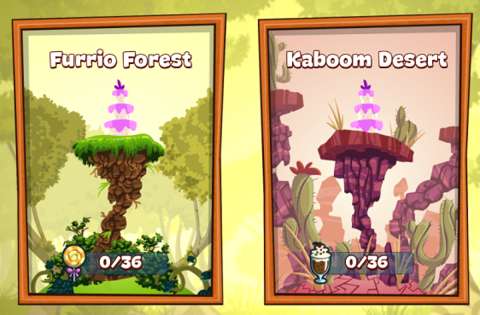
Of course, the preceding passage is really nothing more than an attempt to make sense of the whimsical settings of the Eet series. It should have sufficed to say that Eet wants to have cake and the player is tasked with leading it there.
USER INTERFACE:
The computer version of Eets Munchies is obviously a port of the original version, which came out on the mobile platforms; this can be seen from the huge buttons in the user interfaces, which appear to be more at home on touch-screen tablets. Nevertheless, the user interface is still adequate for the gameplay in the computer version.
TUTORIAL:
Klei has wisely decided to forgo heavily text-based tutorials in favour of tutorials with sparse but understandable visual indicators. The gameplay in Eets Munchies is not particularly complex after all.
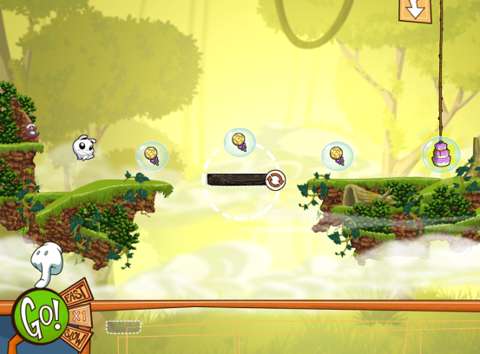
HAVING CAKE AND EATING IT TOO:
As mentioned earlier, the player’s objective is to lead Eets to the cake by manipulating the level to get Eets safely to the tasty delight.
Florid terms aside, such gameplay is nothing new; it has been around since Lemmings. If one is to find a more recent example of a game which is about leading a creature to somewhere, an example is MouseCraft, which is a close indie contemporary of Eets Munchies.
Anyway, in addition to leading Eets to the cake, the player can also try to get it to move across floating candies and other snacks. These count as secondary collectibles; they contribute towards the unlocking of additional objects which can be used for the creation of puzzles and the unlocking of ‘mystery puzzles’ (i.e. bonus levels).
At this point, a person who is rather familiar with this secondary goal would be saying “so far, so typical”.
However, there are a few pleasant nuances which make Eets Munchies a bit different from other games of its ilk. For one, the level does not end right away after Eets gobbles the cake; if there happens to be any secondary collectibles in Eets’s way when it is yanked upwards by the rope, it will collect them.
This will not be immediately obvious to new players of course, but observant and curious players can discover this through one of the regular levels in the “Kaboom Desert” set.
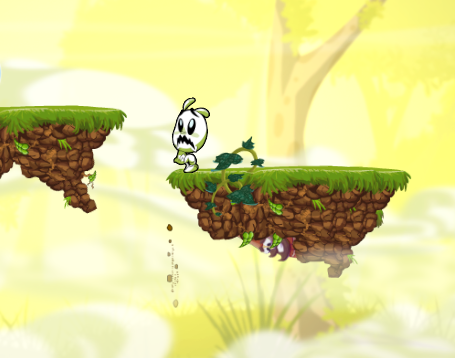
SPEED:
Conveniently, there is a feature to speed up the proceedings or slow them down. This is useful when the player is assured that the solution works, or when the player needs to micromanage timings.
PLACING OBJECTS:
To guide Eets to the cake and other edibles, the player has to place objects in its path. This can be done at the start of the level, before having Eets begin its saunter. Success at a level is very much dependent on the placement of objects, so the player must know what each object does.
Conveniently, the player can make use of at least one hint for every “regular“ puzzle level. This hint lets the player know where best to place one object. Observant players may also notice that some levels have platforms with shapes which can conveniently accommodate objects which have to be placed.
EETS’S JUMPING:
Eets may be dim-witted, but it is aware that it is living in a world of precarious platforms. When it reaches the edge of a platform, it will by default leap – regardless of whether there is a platform ahead or not. If there is not any, Eets just jumps off into the abyss and the player will be back at square one.
This bit about Eets’ behaviour is what makes the game reminiscent of Lemmings. The player must set paths or obstacles in Eets’s way in order to get it to the cake safely, usually by having it jump when it should.

ALTERING EETS’S BEHAVIOR:
Eets is usually a chippy creature, eager to jump around and get the cake when it sees it. However, its behaviour can change, usually through eating snacks in its path. (It is quite the glutton.)
Gameplay-wise, Eets’ ability to jump, among other things, is changed after eating them. To indicate this, Eets’s sprite changes visibly.
As for the snacks, there are three of these. There are chilli peppers which when eaten, increase Eets’s jumping height. There are onions, which when eaten, make Eets skittish and fearful, for whatever reason; at the very least, Eets becomes more aware of edges. Finally, there are cupcakes, which cause Eets to revert to its default nature.
These snacks are gradually introduced to the player and will eventually be unlocked as objects which can be included in a custom-designed puzzle.
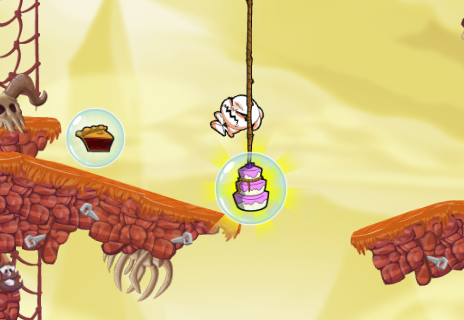
PLATFORMS:
The pre-existing floating platforms in the levels are usually not enough for Eets to get to where it is needed. Therefore, in the levels where this is the case, the player is given some platforms to place so that Eets can walk onto them.
Some of these platforms are bland wooden ones (though some players might be amused that they are wooden).
Then, there are platforms which become solid when conditions are met but become incorporeal at other times. These are a staple in puzzle/platforming games; WayForward’s Mighty Switch Force is an example of a non-Klei game. Klei is no stranger to such gameplay elements, so in Eets Munchies, they have tied this element to Eets’s mood, conveniently enough.
The game usually does a good job of snapping the edges of these platforms to the edges of pre-existing platforms when the player places the former close to the latter. However, there are occasions where the snapping is not as adequate as the player would think; in these occasions, Eets refuses to walk over them. The player will need to restart the level to correct the mistake.
Of course, restarting is near instantaneous and the game does remember where the player placed objects.
BOMBOS & BOMB CARTS:
Bombos are bombs which explode when they fall from great heights; this much is told to the player by the game.
What the game does not tell the player though, is that Bombos will explode when they hit other things while being hurled through the air or vice versa. They also blow up when other things drop onto them from great heights.
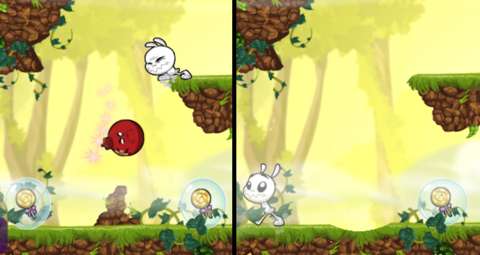
Without resorting to a guide, the player has to learn these other properties of Bombos through trial-and-error and, of course, observation.
Bomb carts are a bit more reliable than Bombos, because they blow up only when the player clicks/taps on them. However, they do roll about, so getting them to the right places can be tricky.
Explosives can create edges on bombed-out platforms, which then force Eets to make jumps at these edges. Timing the explosions to create edges is another matter of course.
GRAVITY:
All optional collectibles float, but the snacks which alter Eets’s behaviour do not. They actually fall and tumble some more when they land; when they tumble, their shapes actually matter. The player must keep this in mind when placing them, or else they just tumble off the level or land somewhere and lead to some embarrassing guffaws.
There are some anthropomorphic contraptions and creatures which bend the rules of gravity, such as fans which blow things in specific direction. There are also pesky crows which suck in any nearby loose objects (and Eets too, if it gets too close). Making use of their physical influences can be a bit frustrating at times, but amusing when the player can get it right.
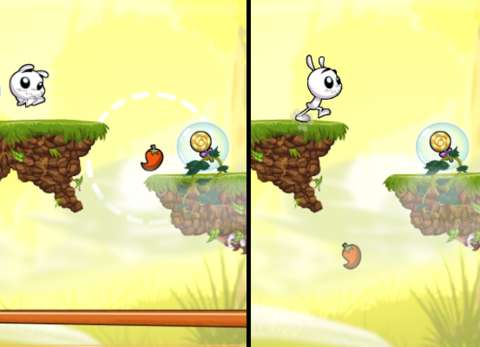
PUSHING THINGS:
Early on in the game, there is a level which will demonstrate to the player, through its solution, that Eets can push things around as it moves about. Eets is not the only thing which can push other things around though. Inanimate loose objects can also push other things around if they have the momentum for that.
Eets simply collects any optional collectibles which it comes into contact with. However, if any other moving things come into contact with optional collectibles, they push the latter around. This likely has to be learned by making a lot of silly mistakes and observing the consequences, assuming that the player does not resort to looking at guides.
In any case, the player will need to make use of this lesson to solve the more complicated puzzles, which begin to appear in the second stage and become more common afterwards.
COLLISION MOMENTUM & EXPLOSIONS:
As mentioned earlier, things can push other things around if they have the momentum. If an object has more momentum when it hits another object, the other object is shoved further by the impact. This should be understandable enough if the player has a good grasp of physics.
The explosions of Bombos also impart momentum. This is a lesson which might be learned by having mishaps with the bombs.
Learning how to use momentum to solve puzzles can be quite entertaining – at least when the player does not need to worry about rebounds after things land. Unfortunately, there are some puzzles where the rebounds are just as important as getting collisions to happen. The player has very little control over the rebounds, so these puzzles can be frustrating.
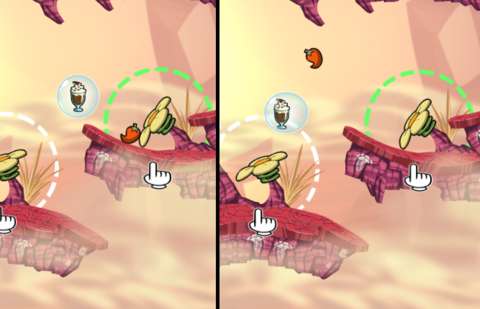
PROJECTILES:
The only objects who do not follow the rules on collisions and gravity are projectiles. It will not take long for the new player to identify what objects are projectiles: these always fly in straight trajectories. Projectiles are also the only objects which can redirected by arrows.
However, puzzles which require the use of projectiles can seem more reflex-intensive than other puzzles. (There will be more elaboration on this minor complaint later.)
WEIRD ANIMALS & CONTRAPTIONS:
The player’s involvement in a puzzle does not just end at the placement of objects. Some objects can be interacted with, either through poking at them with mouse-clicks (or screen-taps) or through having other objects touch them.
The first example of these is the Inhale Whale, a creature which can suck in the closest loose object – including Eets – and spit it out in a projectile arc. Momentum is not conserved when it does this, which is something to keep in mind.
Another example is the cannon. It fires loose objects of any kind (which can include snacks), depending on the design of the puzzle. The nuance about the cannon is that its “ammunition” does have some momentum; indeed, there are puzzles which require the player to use the cannon to knock things over.
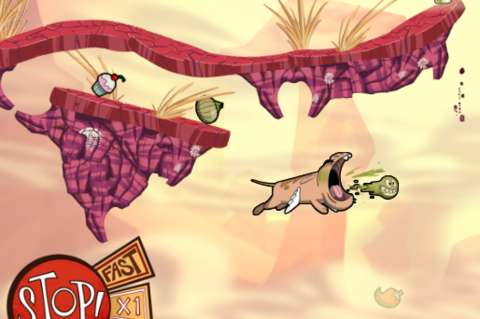
Yet another example is a cart which Eets would get into (for whatever reason) when Eets is near it. Eets can be ejected out of the cart at the right time to collect some goodies. Alternatively, Eets can still collect goodies while it is still in the cart. Amusingly, the cart can also be used to keep objects.
The use of these weird animals and contraptions do require reflexes as much as intellect, however. This catch will be described further soon.
SOME REFLEXES NEEDED:
For better or worse, there are a handful of puzzles in the game which require the player to exercise his/her reflexes. These include almost all of the Mystery Puzzles.
To elaborate, there are puzzles which require accurate timing, e.g. clicking on interactive objects at the right time. This is nothing new in puzzle games of course; timing-dependent solutions had been in the genre of puzzle-solving games for decades.
Yet, having to rely on one’s reflexes in addition to one’s brains can be unpleasant, especially for players who prefer that puzzle-solving to be mainly about use of one’s intellect.
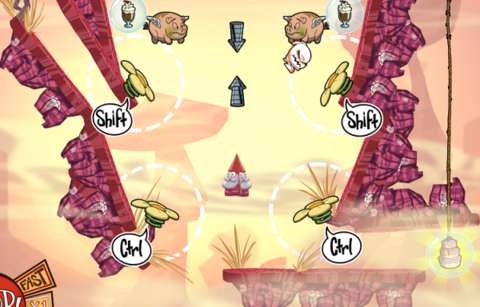
RED HERRINGS:
Another trick which the official puzzles use is placing red herrings. Veterans of puzzle-solving games might be familiar with this trick.
After having learned about the capabilities of objects, the player might think that any object in a level (pre-existing or otherwise) has a purpose and that this purpose involves said capabilities. However, if they are red herrings, they are only there to get in the way of other more important objects.
These puzzles can be off-putting to players who do not like to be misled, but other players would appreciate them as good tests of what they have learned.
PUZZLE-MAKER:
Perhaps in a wise decision, Klei included tools which can be used by the player to create custom-designed levels. However, Klei has also decided that the player’s enjoyment of this feature has to be tied to the player’s performance in the official puzzles.
As mentioned earlier, the player has to have Eets collect secondary collectible items. How many of these which the player needs is indicated by a counter which is shown to the player at the end of a successfully completed level. After the player meets the requirement, the player unlocks the next set of stuff for use in Puzzle-Maker.
This can seem a bit tedious, but it is perhaps implemented with good intentions. After all, the player would be better off having learned about the properties of objects before using them for the design of puzzles.

MYSTERY PUZZLES:
When the player completes a few “regular” levels with flying colours, i.e. collecting all the secondary collectibles in them, he/she unlocks a “mystery puzzle”. This mystery puzzle is more challenging than any of its associated regular levels.
On the other hand, the mystery puzzle usually involves the gameplay elements which are in the associated regular levels, so the player might be able to solve them as soon as they are unlocked.
However, most mystery puzzles also happen to have gameplay elements which the player has yet to see from the later regular levels, so the player might want to hold back on trying them until he/she has learned the nuances of these elements.
For better or worse, the mystery puzzles have solutions which require a lot of timing as well as a lot of clicking. They might not be pleasant to players who have butter-fingers.
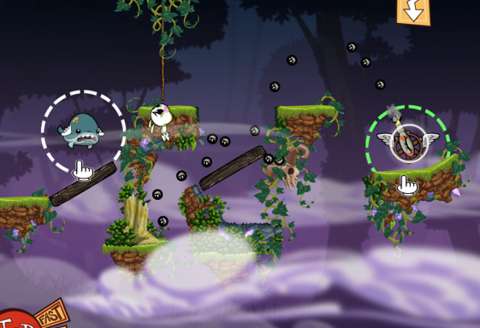
WRITING:
Before Eets Munchies, Klei has made attempts at trying to tell stories. However, it was soon clear why the likes of Shank has a more gripping narrative than Klei’s other titles which have more text: Klei doesn’t have script-writers who are as good as their story directors.
The text in Eets Munchies is mainly – and thankfully – only there for gameplay purposes. For example, all objects have tooltips which inform the player of what they do.
Where the text is not gameplay-related though, the player would find examples of awful puns and cheap word-plays.

VISUAL DESIGNS:
Klei’s artists have always loved artstyles which focus on silhouettes and outlines since their first game, Eets. They continue this tradition of theirs in Eets Munchies, to the benefit of the game.
As befitting an entry in the Eets franchise, Eets Munchies has cartoonish and kid-friendly aesthetics. Yet, its artstyle is also not too far off from that seen in Klei’s other games, e.g. Shank and Don’t Starve. To elaborate, there is an impression of whimsy in some of the animations, such as the animations for the opening of mouths; this is seen in Don’t Starve. There are also trolls, whose scowls more than resemble the scowls of the angry people in Shank.
Eets itself has the most frames of animations. For example, he has one set for each state of mind. The other characters, such as the weird animals, have their own animations too, such as the Inhale Whale’s snickering after it spits things out. These add to the charm of the game.
Eets Munchies does copy some visual designs from other games though. For example, it implements the results of explosions in the same way as Worms had done for years; sprites of affected platforms appear like they have circles cut out of them.
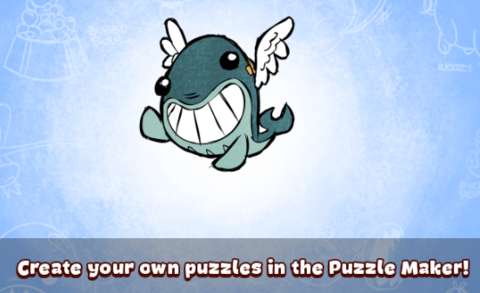
MUSIC GALORE:
Perhaps the most peculiar aspect of Eets Munchies’ aesthetics is its sound design.
All of what the player would hear in Eets Munchies is music; even the explosions are rendered as tunes, specifically harsh cymbal clangs.
The tempo of the music reflects what is happening on-screen as puzzles are being solved (or goofed up). The melody changes when Eets changes its mood. Jumps are accompanied by flourishes. There are plenty more examples to be mentioned here, but it should suffice to say that if Klei wanted music to be part of the gameplay, then it has achieved that goal without turning Eets Munchies into an irritating rhythm game.
The music even changes when the player changes the animation speeds. However, since the music tracks are not packaged separately from the game, there is no sure way to tell whether Klei’s composer designed a separate track for each speed or merely changed the playback rate of the tracks for the default speed.
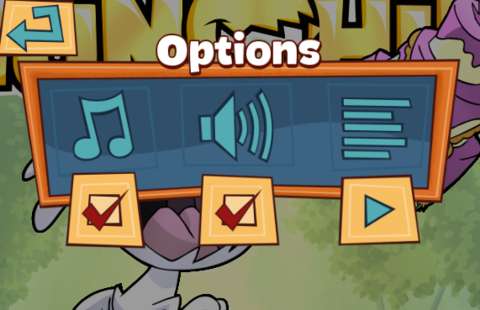
SUMMARY:
For those who are not already familiar with Klei’s Eets series, Eets Munchies may seem like it derived many of its ideas from other games and then gave the results a cutesy sheen. However, it is not just a cheap knock-off with checkboxes of puzzle game tropes to tick away.
Players who have the patience to get through its first impression may find that it does have some “Eureka!” moments when the player learns something new; even jaded players may at least be amused when some puzzle elements do not turn out the way which they expect.
These moments are what makes a puzzle game worthwhile, and Eets Munchies does not disappoint in this regard.

